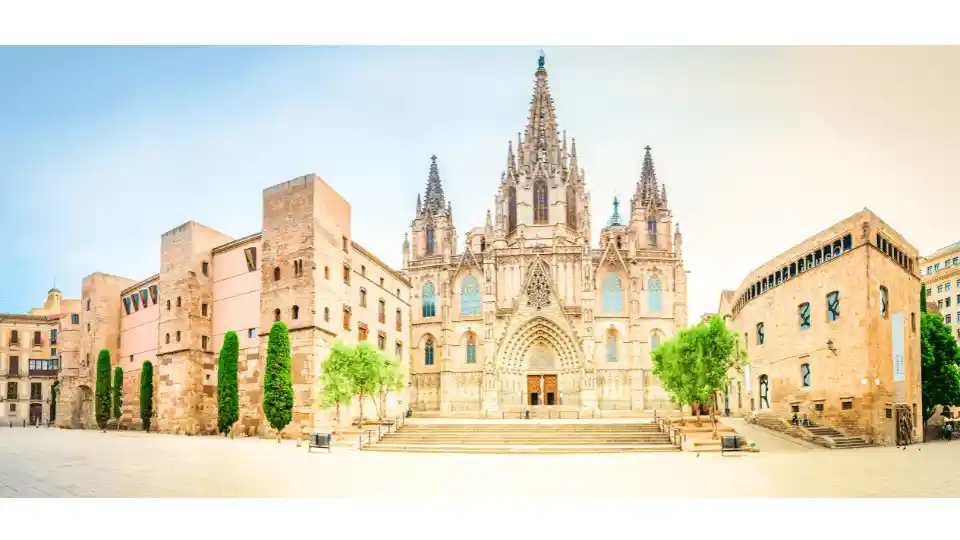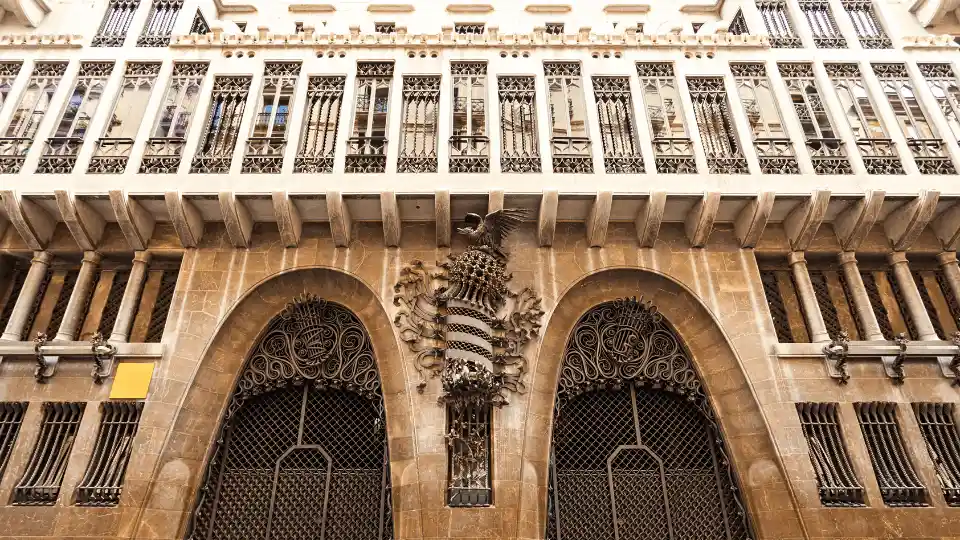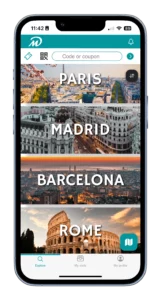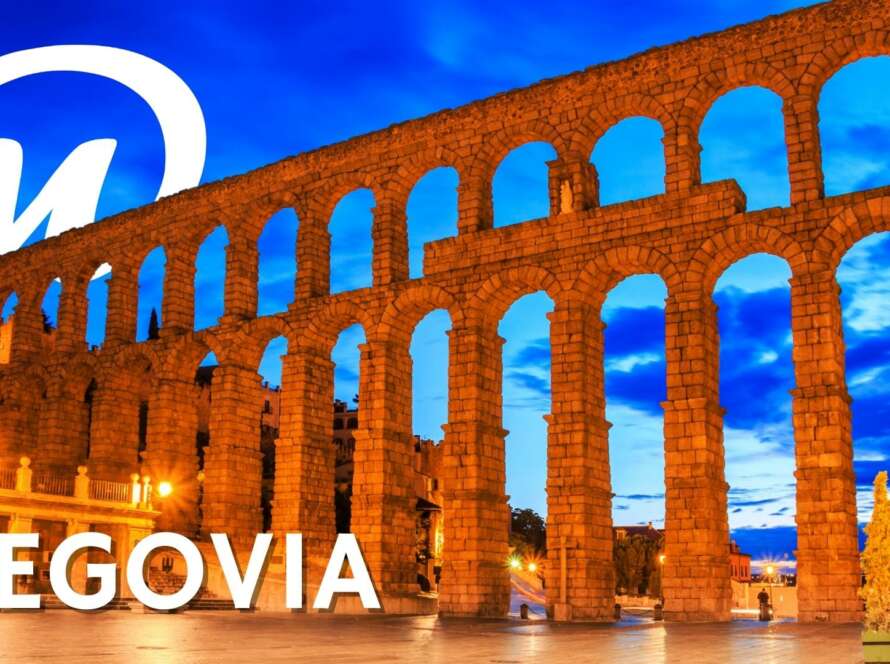If you’re wondering what things to do In Barcelona, DareMapp tells you in this fun interactive tour. Things to do in Barcelona:
⌛ Do you want to keep searching through blogs, or would you rather have your Barcelona guide ready?
The DareMapp app makes it easy. Enjoy the COMPLETE GUIDE ON YOUR PHONE and experience every corner in a unique way. No schedules, at your own pace.
Route: Things to do in Barcelona
The Sagrada Familia: A Monumental Beginning
The Sagrada Familia is Antoni Gaudí’s unfinished masterpiece and a symbol of Barcelona. It reflects the union of creativity, faith and architecture of its famous architect, Antonio Gaudí.
Begun in 1882 and still under construction, it is a UNESCO World Heritage Site. It is estimated that one of its most important towers, the tower of Jesus Christ, will be finished by 2026, marking Gaudí’s centenary. In addition, as a curiosity, we will tell you that this monument is the most visited in Spain, standing out not only for its impressive architecture but also for its profound religious and naturalistic symbolism.
With its façades dedicated to the Nativity, Passion and Glory, and towers that will stand as the tallest among Christian churches, the Sagrada Familia is a must-do among the top things to do in Barcelona.
Paseo de Gracia: Elegance and Modernism
In the heart of Barcelona, Passeig de Gràcia is home to an unparalleled architectural spectacle known as the Apple of Discord. This iconic block features three jewels of Catalan Modernisme, each reflecting the unique vision of its celebrated architects, making them must stop for those looking for things to do in Barcelona:
Antoni Gaudí’s Casa Batlló. It stands out for its façade that simulates the waves of the sea and the decorative details reminiscent of living beings, being a tribute to the artist’s representative art and nature. Check your tickets here.

The Casa Lleó Morera, designed by Lluís Domènech i Montaner, this building is a marvel with its rich ornamentation, which includes sculptures and ceramics of all colours. It also has a legend in its composition, the legend of Saint George. If you are detailed, you will find it easily, but if not, we’ll tell you about it! Download the app and discover it.
Finally, the Casa Amatller by Josep Puig i Cadafalch, a unique blend of Gothic style with Dutch influences, is a last stop to have or buy a famous Amatller🍫 chocolate.
⤵️ Definitively, you want to have your trip already organized. Want to discover how?
With the app DareMapp, forget about wasting time. Enjoy Barcelona at your own pace, with no schedules, using our complete self-guided tour. The whole city, in one place, your phone.
These three masterpieces offer a window into the creative soul of Barcelona, making the Apple of Discord a must of the things to do in Barcelona. As a bonus, we can’t forget to mention Gaudí’s Casa Milá, also located on the promenade itself.
Gothic Quarter: A Journey to the Past
The Gothic Quarter is the historic heart of Barcelona. Although its name evokes the Gothic, many of its buildings are more recent, the result of ingenious 19th-century marketing. Among the essential things to do in Barcelona:
Plaza de Sant Felip Neri: a haven of peace with a tragic past; the shrapnel marks on the church are silent witnesses to the bombing during the Spanish Civil War.
The Kiss Mural: a work composed of thousands of photos forming a mosaic depicting a kiss, symbolising love and freedom.
Barcelona Cathedral: an imposing example of Catalan Gothic architecture with 13 white geese hidden in its cloister, representing the years of life of Santa Eulalia, one of the city’s patron saints.

Columbus Monument and Surroundings
The Columbus Monument, located at the end of Las Ramblas and close to the sea, is one visit part of the most emblematic things to do in Barcelona. This imposing column, erected in honour of Christopher Columbus, stands 60 metres high and offers a panoramic view of the city from its vantage point. Columbus, with his finger pointing out to sea, not only commemorates his return from America in 1493, but also symbolises Barcelona’s historical relationship with the sea and exploration.
The area around the monument is equally fascinating; the Port Vell, the city’s old port transformed by the Olympics, is now a lively space; the Barcelona Aquarium, one of the largest in Europe dedicated to Mediterranean marine life; and the Maritime Museum, which houses the city’s naval history, one of the most important in the country.

Palau Güell and Liceu Theatre
The Palau Güell is one of the first works of the famous architect Antoni Gaudí. Located on Barcelona’s famous Ramblas, it stands out for its combination of functionality and aesthetics. Gaudí was faced with a great challenge when he had to build a palace in such a small space… Definitively, an amazing visit part of the most curious things to do in Barcelona with its gaudanian Phoenix.
A few steps away, you will find the Gran Teatre del Liceu, known simply as the Liceu, which stands as one of the most important opera houses in Europe. Founded in 1847, it has been a centre of culture and music, presenting some of the best operas and performances in the world. Despite being rebuilt after a fire in 1994, the Liceu retains its original splendour, with a luxurious interior that echoes its rich cultural past.

👁️ Still searching?
What you’re looking for is already here.
With the DareMapp app, explore Barcelona like never before: interactive tours, tips, and routes all in your mobile.
What to See in Barcelona: Other Things to Do
Palau de la Música Catalana: A modernist gem by Lluís Domènech i Montaner, it offers self-guided tours from €18 and guided tours for €22, allowing you to admire its spectacular concert hall without waiting in line.
Picasso Museum: Located in El Born, this museum houses an extensive collection of the artist’s works. The guided tours we suggest (link included) are in small groups and include skip-the-line access and detailed explanations by an expert.
Joan Miró Foundation: Situated on Montjuïc hill, this foundation showcases the largest public collection of Miró’s works, in a building designed by Josep Lluís Sert — perfect for a family visit.
National Art Museum of Catalonia (MNAC): Located in the Palau Nacional on Montjuïc, this museum is renowned for its Romanesque art collection. General admission is €12 and free from 3:00 p.m., though booking in advance is recommended.
Park Güell: One of Gaudí’s most iconic works, it offers guided tours of the monumental zone where you can explore its colorful mosaics and unique architecture.
Barcelona Zoo: Located in Ciutadella Park, it is home to over 300 species and participates in conservation projects like the Cryo-Zoo, which preserves cells of endangered animals.
Tibidabo Amusement Park: With more than a century of history, this park offers both classic and modern rides, along with panoramic views of the city from Mount Tibidabo.
PortAventura World: A theme park complex on the Costa Dorada featuring several themed areas and attractions. Currently, it’s facing a labor strike that may affect some services, although the park remains open.
Golondrina Boat Ride: Traditional boats offering one-hour trips along Barcelona’s coastline, giving you unique views of the city’s skyline and the Mediterranean Sea.
Catalan Gastronomy: Things To do In Barcelona
Barcelona is not only history but also has a rich, never better said, local gastronomy!
With DareMapp you will not only know the things to do in Barcelona, but also what to eat!
Let’s not forget that when exploring these things to do in Barcelona, Catalan gastronomy has a lot to offer. From tapas bars tucked away in the narrow streets of the Gothic Quarter to Michelin-starred restaurants, Barcelona is home to a thousand flavours thanks to its rich diversity. Here are some of the city’s most famous dishes:

- Pa amb Tomàquet: This simple but delicious dish, bread with tomato and a touch of olive oil and salt, is a staple on any Catalan table. Many people wonder, with or without ham? In Catalonia it is exclusively without ham, highlighting the unique flavour of the rich tomato.
- Escudella i Carn d’Olla: Considered the first soup dish in Europe, this rustic stew combines meats, sausages and vegetables, perfect for cold days and to understand the Catalan cuisine.
- Calçots with Romesco Sauce: During the season of calçots (spring onions), this dish becomes a reason for gathering and celebration. Roasted over a flame and accompanied by the exquisite romesco sauce, they offer a unique gastronomic experience that attracts many gourmets to Catalan cuisine.
Markets and Gastronomic Experiences
Furthermore, one cannot talk about the things to do in Barcelona without mentioning the Boqueria Market.
Originally called Mercado de San José, it has been located on Barcelona’s La Rambla since 1840. With more than 300 stalls, it offers everything from fish to organic products and knick-knacks. As a curiosity, it was chosen as the Best Market in the World in 2005 in Washington. It also has a gastronomic classroom and outstanding bars such as Pinotxo, where you can try all the above dishes. As for its architecture, its modernist arch stands out, adorned with coloured glass.
Despite its popularity with tourists, it is still essential for locals looking for fresh, quality produce. It’s definitely a must-see for those wondering whagt things to do in Barcelona.
🤤 Is your mouth watering already? Don’t worry, we feel the same.
That’s why we make it easy with the best gastronomic stops in Barcelona, selected for you to enjoy without wasting time.
All the information you need is ready.
Say goodbye 👋🏻 to endless scrolling and start truly savoring Barcelona.
Tips to travel with peace of mind
When everything is ready — flights, hotel, itinerary — there are only two more things you need to travel worry-free: a good internet connection and reliable travel insurance.
✔ Get an international eSIM already set up on your phone. No need to change your SIM card, search for Wi-Fi, or pay for roaming. Activate it before your trip and enjoy unlimited data from the very first minute, wherever you are.
✔ Take out travel insurance that includes medical assistance 24/7, coverage for cancellations, theft, and — most importantly — advance payment of all medical expenses without you having to pay, wherever you are. Because in a new country, what matters most is feeling safe. Moreover, DareMapp offers you a 5% discount.
Both services can be arranged online in less than 5 minutes, with no paperwork required.
Don’t leave it to the last minute!
👉 Activate your Holafly eSIM at the best price here.
👉 Take out your travel insurance with IATI and get a 5% discount.
Interesting facts and Things To do In Barcelona
By exploring some things to do in Barcelona, you’ll discover a city full of surprises and curiosities that will amaze you. From its innovative architecture to hidden details in its iconic buildings, Barcelona never fails to impress. Here are 6 curiosities that will make your visit to the city even more special:
- The Symmetry of the Eixample: If you look at it from the air, the Eixample is a perfect grid, testament to the visionary urban planning of Ildefonso Cerdà. This district, designed to be an egalitarian space, is a must among the things to do in Barcelona for its unique blend of classicism in its plan and modernism in its facades.
- A Sudoku in the Sagrada Familia: Among the essential things to do in Barcelona, the Sagrada Familia hides a mathematical enigma. On the Passion façade, there are magic cubes that add up to 33, the age of Christ according to the New Testament, in all their combinations. Bravo Gaudí!
- The Agbar Tower, the Emblem of 22@: Initially greeted with scepticism, the Agbar Tower has become a beloved symbol of innovation and modernity in Barcelona. Designed by Jean Nouvel, inspired by geysers and the Catalan landscape, the tower is an essential stop on these things to do in Barcelona. Its sustainable design and night-time lighting make it a contemporary jewel in dialogue with the city’s rich urban fabric.
- Spain’s Busiest Street: Puerta del Angel is the busiest street in Spain. It is a living example of the dynamism that characterises Barcelona, making it an unmissable experience among the things to do in Barcelona, but watch your wallet!
- The Eiffel Tower and Barcelona: A curious fact that surprises many is that the Eiffel Tower may have originally been built in Barcelona. However, it was thought that it would not fit in with the aesthetics of the city.
- Europe’s Biggest Stationery Shop: Raima, located on Carrer Comtal, is more than just a stationery shop. With its five floors full of surprises and unique decoration on each level, Raima is a hidden treasure over the things to do in Barcelona. This megastore is a paradise for stationery lovers, being the largest paper shop in Europe.
Other things to do in Barcelona:
- Get your Barcelona Card
For a hassle-free experience, the Barcelona Card gives you unlimited public transport and access to top attractions—one of the most convenient things to do in Barcelona for visitors looking to explore the city easily. Check your tickets here. - Visit the Palau de la Música Catalana
Admire one of Barcelona’s architectural masterpieces without waiting in line. A visit to Palau de la Música Catalana is one of the most impressive things to do in Barcelona, perfect for music and design lovers. Check your tickets here. - Museo Picasso
For art lovers, a skip-the-line ticket with a guided tour of the Picasso Museum is one of the top things to do in Barcelona, offering an in-depth look at the artist’s early works and evolution. Check your tickets here. - Explore the Fundació Joan Miró
Dive into the world of surrealism at the Joan Miró Foundation, one of the most cultural things to do in Barcelona for contemporary art lovers. Check your tickets here. - Learn at the Museu Nacional d’Art de Catalunya
Explore Catalan art through the centuries at MNAC, an essential stop for art lovers. Visiting this museum is one of the most enriching things to do in Barcelona. Check your tickets here. - Go to the Park Güell
One of Gaudí’s most famous works, Park Güell is a must-visit for its colorful mosaics and unique architecture. A guided tour enhances the experience, making it one of the most iconic things to do in Barcelona. Check your tickets here. - Visit the Barcelona Zoo
Perfect for families, Barcelona Zoo is home to a wide variety of animals and interactive exhibits. Visiting the zoo is one of the best things to do in Barcelona with kids. Check your tickets here. - Have fun at the Tibidabo Amusement Park
For a mix of fun and stunning city views, Tibidabo Amusement Park is one of the most entertaining things to do in Barcelona, offering classic rides and breathtaking panoramas. Check your tickets here. - Enjoy at PortAventura
Just outside the city, PortAventura is Spain’s top theme park, featuring thrilling roller coasters and themed attractions. A day trip here is one of the most exciting things to do in Barcelona for adventure seekers. Check your tickets here. - Experience 1-Hour Golondrinas Boat Ride
Relax on a Golondrinas boat tour and admire Barcelona’s coastline from the sea. This one-hour boat ride is one of the most scenic things to do in Barcelona, perfect for a break from sightseeing. Check your tickets here.
With so many incredible things to do in Barcelona, your trip will be packed with unforgettable moments. Which experience will you try first? 🚀🏛🎭
Things To do In Barcelona: history
Barcelona, one of Spain’s most vibrant and cosmopolitan cities, has a rich and fascinating history dating back to ancient times. From its humble origins to its current position as a global destination, Barcelona’s evolution is an exciting journey that deserves to be explored. If you’re wondering about the things to do in Barcelona, learning about its history is an excellent way to appreciate its cultural and architectural richness.
The earliest settlements and the foundation of Barcino
Barcelona’s history begins in ancient times, when the Romans founded the city under the name of Barcino in the 1st century BC. Its strategic location on the hill of Montjuïc and its proximity to the Mediterranean Sea made it a point of interest for Roman traders and strategists. In the centre of Barcino, you can still see traces of Roman walls today, a tangible proof of the city’s historical importance. If you are looking for things to see in Barcelona, the ruins of Barcino are a fascinating testimony to its origins.
The Middle Ages: Expansion and Culture
During the Middle Ages, Barcelona experienced significant growth. In the 8th century, the city was occupied by the Visigoths, and later, in 801, it was reconquered by the Carolingian Empire under the leadership of Louis the Pious. This period marked the beginning of a cultural and economic flowering that consolidated Barcelona as an important centre of commerce and culture. The streets of the Gothic Quarter, a medieval labyrinth that is still preserved today, are one of the must-see places in Barcelona for any history buff.
The city also played a crucial role during the Middle Ages in the expansion of the Crown of Aragon, and the splendour of this era is reflected in buildings such as Barcelona Cathedral. Built between the 13th and 15th centuries, this cathedral is a magnificent example of Gothic architecture and a highlight for those who want to know what to see in Barcelona.
Renaissance and Baroque: The Rise of Barcelona
The Renaissance and Baroque periods brought significant changes to Barcelona’s architecture and urban planning. During these centuries, the city expanded beyond the medieval walls, giving rise to new neighbourhoods and avenues. The 19th century, in particular, saw a radical transformation with the renewal of the Cerdà Plan, designed by the urban planner Ildefons Cerdà. This plan led to the creation of the Eixample, a modern area with wide avenues and Art Nouveau buildings, a golden period in Barcelona’s architectural history.
If you explore the city today, Catalan modernisme is an essential part of what to see in Barcelona. Masterpieces such as Antoni Gaudí’s Sagrada Familia, Casa Batlló and La Pedrera are outstanding examples of this era. The Sagrada Familia, in particular, is one of the most iconic and anticipated structures on any visit to Barcelona.
20th Century: Transformation and Modernity
The 20th century brought with it a series of challenges for Barcelona, including the Spanish Civil War and Franco’s regime, which left a mark on the city. However, post-Franco Barcelona began to revive and modernise in a remarkable way. The hosting of the 1992 Olympic Games was a crucial turning point that transformed the city into an international tourist destination. Modern infrastructures, renovations to the port and the revitalisation of the beaches have made Barcelona a reference point in world tourism.
Today, Barcelona is known for its vibrant cultural scene, international festivals and nightlife. The Raval neighbourhood, Park Güell, and the Boqueria Market are just some of the many fascinating places visitors can explore. Barcelona’s museums, such as the Picasso Museum and the National Art Museum of Catalonia, offer a deep dive into the city’s rich artistic heritage.
💫 You’re one click away from turning reading into adventure.
🗺️ Your route through Barcelona, with DareMapp

Barcelona Today: A Global Destination
Today, Barcelona remains a city of contrasts, where the ancient and the modern coexist in harmony. Its rich history is intertwined with a vibrant city life, offering a wide range of experiences for visitors. If you’re wondering what to see in Barcelona, bear in mind that the city is not only an epicentre of architecture and culture, but also a place where history comes alive at every turn. From the charm of its Roman past to the dynamism of its contemporary present, Barcelona offers an unforgettable experience for everyone.
Summary
Barcelona is a city with a fascinating history that stretches from Roman times to modern times. Founded as Barcino in the 1st century BC, the city has evolved over the centuries, from its role in the Middle Ages as an important centre of trade and culture, to its transformation during the Renaissance and Baroque periods. The 20th century marked a turning point with the 1992 Olympic Games, which revitalised the city.
Today, Barcelona combines its rich historical heritage with a vibrant modern life. If you’re planning your visit, don’t miss the iconic sights to see in Barcelona, such as the Sagrada Familia, the Gothic Quarter, and Park Güell, which will offer you a full immersion into the history and culture of this vibrant city.
Whether you’re strolling through the narrow streets of the Gothic Quarter, admiring the works of Gaudí or enjoying the lively life on the Ramblas, Barcelona is a city that continually surprises and delights visitors. Barcelona’s history is a reflection of its ability to adapt and thrive, making every visit an opportunity to discover something new.
If you want to discover more routes, curious facts and useful information for your trip, click here.
Remember that with DareMapp you can take a multitude of interactive guided tours, including many of these “Spain’s most famous routes”, a fun tour of the main destinations.
What better way than travelling and discovering while learning in a fun way? Visit our blog to discover lots of tourism tips.





